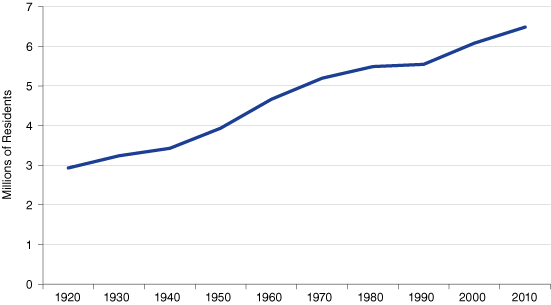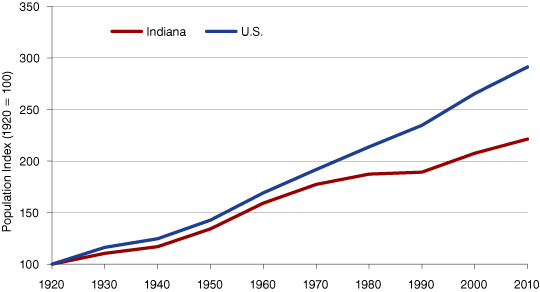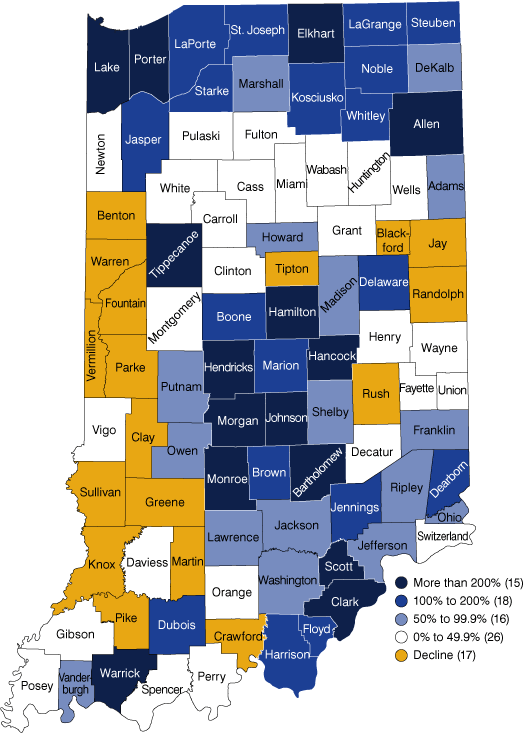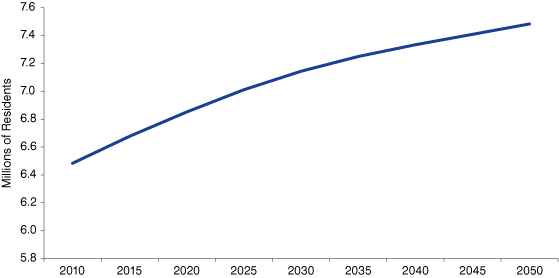90 Years and Indiana Doubles Its Population
This year marks the Indiana Business Research Center’s 90th anniversary.
To commemorate the occasion, InContext will feature several articles over the course of the year that look back to see how the state of Indiana has changed over the last 90 years. In this issue, we explore how Indiana’s population has grown and shifted.
For this article, we will use population counts from the decennial census to look at the 1920-2010 time frame. Indiana’s population more than doubled over these 90 years. In 1920, the state had nearly 3 million residents (2,930,390) and almost 6.5 million (6,483,802) by 2010 (see Figure 1).
Figure 1: Indiana Population, 1920 to 2010

Source: IBRC, using U.S. Census Bureau data
Growth Trends over Time
Table 1 shows that Indiana saw the largest population gains between 1950 and 1960 (when the majority of baby boomers were born), adding 728,274 residents for a 19 percent gain. On the flip side, population growth was essentially stagnant during the 1980s, when Indiana and the nation suffered through a double-dip recession. Indiana had a scant 1 percent increase in population between 1980 and 1990, as tens of thousands of Hoosiers sought opportunities elsewhere.
Table 1: Indiana's Population Change Decade by Decade, 1920 to 2010
| Year | Population | Change from Previous Decade | |
|---|---|---|---|
| Number | Percent | ||
| 1920 | 2,930,390 | 229,514 | 8% |
| 1930 | 3,238,503 | 308,113 | 11% |
| 1940 | 3,427,796 | 189,293 | 6% |
| 1950 | 3,934,224 | 506,428 | 15% |
| 1960 | 4,662,498 | 728,274 | 19% |
| 1970 | 5,195,392 | 532,894 | 11% |
| 1980 | 5,490,210 | 294,818 | 6% |
| 1990 | 5,544,159 | 53,949 | 1% |
| 2000 | 6,080,485 | 536,326 | 10% |
| 2010 | 6,483,802 | 403,317 | 7% |
Source: IBRC, using U.S. Census Bureau data
Figure 2 illustrates how Indiana’s growth has compared to the nation. While consistently growing more slowly than the nation, Indiana growth was fairly close behind the national rate until the 1970s. Since then, people have become much more mobile and have followed jobs to the southern and western parts of the country.
Figure 2: Indiana's Population Growth Relative to the United States, 1920 to 2010

Source: IBRC, using U.S. Census Bureau data
Geographic Shifts across Indiana
Marion, Lake, Allen and St. Joseph counties (home to Indianapolis, Gary, Fort Wayne and South Bend) have been among the state’s most populous counties since 1920.1 In 1920, those four counties comprised 25 percent of Indiana’s total population. That number rose to 36 percent by the 1960s and 1970s, and settled at 31 percent by 2010.
It is interesting to note that Vigo County (home to Terre Haute) was the state’s fifth largest county in 1920, but today it ranks 17th due to a small 8 percent growth in the 90 years between 1920 and 2010. Meanwhile, Hamilton County (home to Carmel/Fishers) grew by 1,034 percent over that time frame, skyrocketing from 38th in 1920 to fourth place in 2010.
Figure 3 shows the 90-year percent change in population for all 92 Indiana counties. While 33 counties have more than doubled, 17 counties have fewer residents today than they did in the 1920s.
Figure 3: Percent Change in Population by Indiana County, 1920 to 2010

Source: IBRC, using U.S. Census Bureau data
Looking Ahead
While we don’t know how Indiana’s population will change in the next 90 years (we do project the county and state populations twice each decade, but only 40 years out), the Indiana Business Research Center has projected Indiana to top 7 million by 2025 and reach 7.48 million by 2050 (see Figure 4).
Figure 4: Indiana Population Projections, 2010 to 2050

Note: The 2010 data are census counts from the U.S. Census Bureau.
Source: Indiana Business Research Center
For more historical data and projections for Indiana and its counties, visit the Population and Population Projections topic pages on STATS Indiana.
